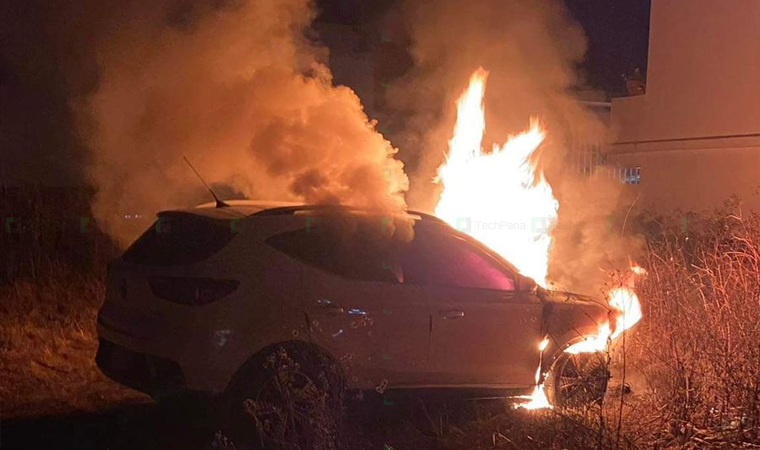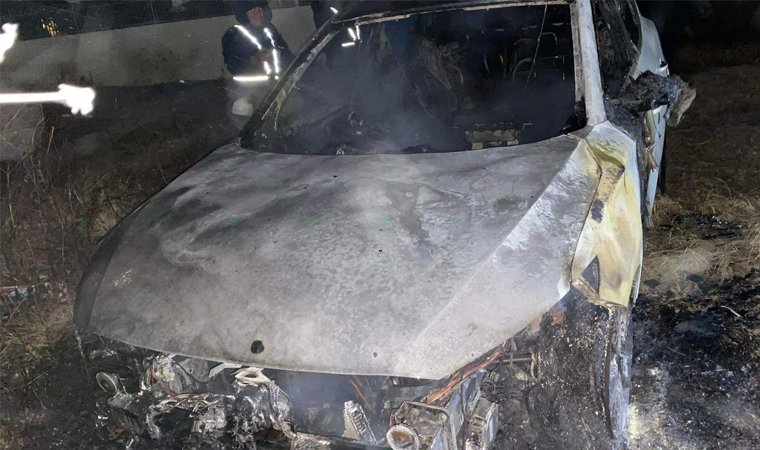Quality Concerns Rise over Electric Vehicles in Nepal after MG ZS EV Fire
The MG ZS EV, however, appears to have employed a substandard battery and power circuit system, resulting in extensive damage.
MG ZS EV Engulfed in Flames, Pic: Chakrapath Police
KATHMANDU: The MG ZS EV, an electric car from MG Motors of China, suffered severe damage in a fire during the charging process in Budhanilkantha Municipality. The incident transpired around 1 AM on the night of December 25, resulting in the total destruction of the vehicle. The electric car, stationed for charging near Budhanilkantha, unexpectedly caught fire.
The local police promptly reported the incident. The MG ZS EV, identified by registration number Bagmati Pradesh-01-027-1581, was parked in an open space during the charging session.
The fire erupted at approximately 1 AM while the car was actively charging. Despite the intensity of the fire, the Kathmandu Metropolitan Police Department in Budhanilkantha assured that no casualties were reported. The Local Police has confirmed the incident.
Inquiries into the cause of the fire in the MG ZS EV are underway, the official distributor for MG Motors in Nepal, Paramount Motor representatives have declined to comment on the Budhanilakantha accident involving the MG ZS EV. Paramount Motors holds the authorized dealership for MG Motors in Nepal.
The risk factor
The incident involving the MG ZS EV in Budhanilkantha Municipality has raised concerns about the quality of electric vehicles (EVs) being sent to Nepal, particularly the potential use of substandard materials.
Reports suggest that the Chinese car manufacturer may have incorporated low-quality materials in the vehicle, and it appears that this specific model was designated exclusively for the Nepalese market. This situation highlights the necessity for a robust quality control system in Nepal, especially concerning EVs.
The lack of stringent quality control measures in the country, particularly for electric vehicles, is becoming evident as safety issues arise. It is crucial for authorities to establish and enforce comprehensive regulations to ensure that vehicles meet international safety and quality standards before entering the Nepalese market.
Raises Concerns over Battery Quality and Safety Protocols
This heightened risk is primarily due to poor-quality battery design and construction, as well as the use of unapproved chargers. Electric cars and trucks feature more sophisticated designs with advanced cooling systems.
These systems maintain the batteries at optimal temperatures during everyday driving and recharging, making them significantly safer than batteries in smaller electric vehicles. However, this MG ZS EV has preliminary found that it has used a very poor quality of battery and power circuit system and that had damaged the entire car.
The heightened risk in the MG ZS EV fire incident stems from subpar battery design, construction, and the use of unauthorized chargers. Unlike smaller electric vehicles, electric cars and trucks incorporate advanced cooling systems that regulate battery temperatures for safety. The MG ZS EV, however, appears to have employed a substandard battery and power circuit system, resulting in extensive damage.
This underscores the critical role of quality control in the manufacturing process. The incident highlights the importance of adhering to industry standards and regulations to ensure the safety and reliability of electric vehicles. Investigations into the specific factors contributing to the fire are ongoing, emphasizing the need for rigorous testing and compliance with safety protocols in the electric vehicle manufacturing sector.
Wake-up call for the consumer
This incident serves as a wake-up call for both regulatory bodies and consumers, emphasizing the need for thorough scrutiny of the manufacturing and safety standards of EVs imported into Nepal. Implementing rigorous quality control mechanisms will not only protect consumers but also contribute to the development of a safer and more reliable electric vehicle market in the country.
MG ZS EV Fire Exposes Disturbing Safety Gaps in Nepal’s Electric Vehicle Market
As the adoption of electric vehicles continues to grow, it becomes increasingly vital to address the potential risks associated with battery fires. Proper training, awareness, and adherence to safety protocols are essential to ensuring the safe use and management of electric vehicles, protecting both the environment and public safety.

Challenges and Hazards in Handling Ignition and Explosion Incidents
The majority (about 95%) of electric vehicle battery fires fall under the category of ignition fires, characterized by jet-like directional flames. The remaining 5% involve vapor cloud explosions. Various factors, such as accidents, manufacturing defects, battery faults, workshop repairs, arson, external fires, or overheating, can trigger a battery fire.
Managing electric vehicle fires presents unique challenges due to the difficulty in controlling ignited batteries. Lithium battery fires burn at exceptionally high temperatures, lasting for days and causing extensive damage, with a tendency to reignite even after initial suppression.
Inadequate handling of these fires can lead to the release of highly toxic gases and chemicals, underscoring the importance of well-trained firefighting crews.














Facebook Comment